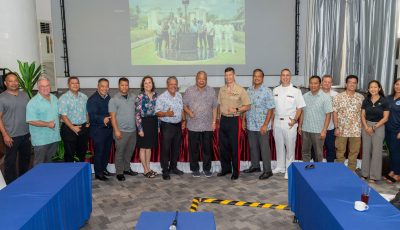DUE TO LACK OF GUARANTEED FUNDING
‘Tinian divert airfield doubtful’
Air Force sells reduced divert scope anew
U.S. Air Force officials trumpeted yesterday revised plans for a divert airfield on Saipan and/or Tinian that they say would reduce the scope and footprint of the larger and more intrusive plans shared in 2012.
According to Air Force officials yesterday, they aim to gather community buy-in for three airfield projects on Saipan that they say would meet directed timelines set by the Secretary of the Air Force and congressional funding windows before fiscal year 2018.
Business leaders are worried, though, that the commercial benefits of a divert “hybrid” option, which spreads out divert facilities on both Saipan and Tinian, may not be realized if selected by the Air Force, as the $29.3 million appropriated by Congress in 2014 remains authorized only for Saipan, despite efforts by Delegate Gregorio Kilili C. Sablan (Ind-MP) last year to expand funding to Tinian.
Business leaders within the Saipan Chamber of Commerce are concerned that shrinking Defense budgets and congressional infighting would eliminate the chances for funding the much-needed Tinian airport development, and leave a divert airfield solely on Saipan for the foreseeable future.
Col. Michael Cardoza, U.S. Air Force’s chief of Strategy and Plans Division, told Saipan Tribune last night during an open house at Northern Marianas College that once the money was authorized, the Air Force had a certain amount of time to execute the project.
“Yes, the funding is tied” to these deadlines, he said. “We are already at the point where we are going to ask for a year extension on that money.”
“The three-year authorization…we’ll have to get an extension of that,” he added.
The Air Force has to put the money on contract within five years, as they have an appropriation that is good for five years, in a project that is authorized for three years, other Air Force officials explained.
Cardoza also spoke to the Saipan Chamber Commerce yesterday, and led the presentation at an open house meeting at NMC last night.
He stressed in both meetings the possibility of shared infrastructure use on Saipan and/or Tinian, as he said the Air Force would not use fuel, parking, and other infrastructure facilities for majority of the year. The Air Force plans to conduct exercises with tanker aircraft similar to the size and frame of commercial planes that regularly land on Saipan, according to Cardoza.
He said the Air Force plans for six to eight weeks of exercises per year, for about two exercises per year. He emphasized, though, that they really expect to train for two- to three-week exercises, but did not want to undersell training times.
“For the rest of the year, there will be no airport presence here,” he told business leaders yesterday.
Cardoza told reporters later that the Air Force believes that the hybrid alternative is the option that is most mutually beneficial for both sides, reduces the development on Saipan, and puts the majority on Titian.
Cardoza told reporters that under the hybrid plan, development on Saipan would start first. “Those are three projects we have funding for right now.”
“…It would be a small parking ramp, a maintenance facility, and some fuel infrastructure,” he said.
Unfunded mandates
“Some of the back story that has not been provided is that the $29 million that was initially provided in budgeting was only for Saipan,” said Saipan Chamber of Commerce president Alex Sablan in an interview.
“Our concern is that when a decision comes down—with budgets being reduced in the military, budget fights in Congress all the time—the concern that we have is that if the hybrid decision is chosen, there isn’t going to be any funding for Titian.
“Tinian needs the available resources—the tank farm, the aprons, everything that is going to be put into the development there so that they can grow their economy, they can get direct flights, international flights, and be able to increase their opportunities,” he said, noting that Chamber has always taken the position to support a “Tinian first” approach.
“If this hybrid does come forth, the emphasis would be to put all the assets on Tinian first, and then come to the Saipan opportunity. But right now, as we see it, the funding is only for Saipan and the concern we have is that they put the assets on Saipan first and then there is no budget” for Titian.
“We’ve been told directly by the Air Force that there is no guarantee that funding will be provided for a Tinian development, especially since a Saipan proposal has already been made.
“I find it difficult to believe that Congress is going to support two airfields, which are three miles apart on funding level when again, budgets are shrinking in the military,” he added.
Delegate Sablan inserted last year provisions in the National Defense Authorization Act to allow for a divert airfield to be placed at “any suitable location” in the Northern Marianas, backing the CNMI government preference for divert activities on Tinian, where already two-thirds of land is leased to the U.S. military. The provisions, though, were dropped in the eventual NDAA agreement.
However, Congress, in their explanatory statement, welcomed changes if deemed necessary by the U.S. Air Force, and said if “necessary, upon issuing a Record of Decision, we would welcome a legislative proposal from the Secretary of the Air Force to modify the scope or location for the project as currently authorized” by law.
The 2013 NDAA authorized $29.3 million for divert projects on the island of Saipan, the preferred alternative for divert activities in the CNMI, according to the Air Force’s 2012 draft environmental impact statement.
The Air Force aims to release a “final” environmental impact statement in January 2016, with a Record of Decision following in February next year.
The Air Force plans to complete land acquisition 18 months after the Record of Decision in August 2017, according to a timeline shared by Cardoza yesterday, awarding contracts in fiscal year 2017, and by fiscal year 2018 complete construction for the fiscal year 2014 funded military construction projects, or the Saipan divert projects.
According to their revised EIS release last month, the Air Force needs 13.95 acres of land for facilities on Saipan in their hybrid option, which would require a lease from the Commonwealth Ports Authority. They plan for 76.64 acres on Tinian for construction on the northern end of the Tinian airport, and 39.15 acres for construction in the south end. The north end construction will require the construction of a taxiway. The south option would use the existing infrastructure.



























